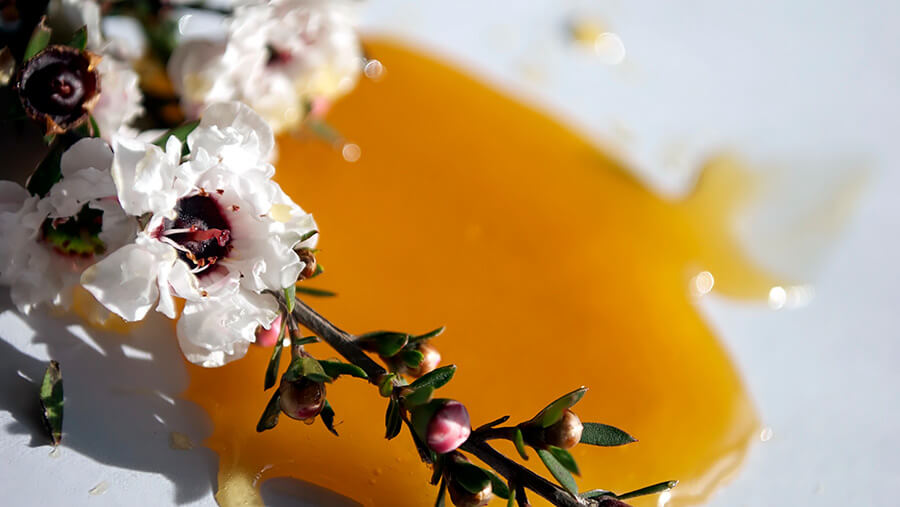The effect of manuka honey is scientifically proven and proven in many practical experiences. Here are my five best tips for the application.
Not only have I had personal experience with Manuka honey for many years, but I have also received and given many training courses. And there I was asked similar questions again and again. That's why you'll find the answers to the most frequently asked questions about Manuka honey here, as well as my personal application tips for the medicine cabinet and skin care.
I first got to know manuka honey over 25 years ago through the New Zealand cosmetics brand Living Nature. Manuka honey is one of many special New Zealand raw materials that owe their existence to New Zealand's isolated location and isolation for thousands of years. I am particularly pleased that so many people have told us about their positive experiences, often after a long odyssey with classic preparations. The effect of manuka honey is scientifically proven and proven in many practical experiences.
My top five tips for using Manuka honey
Tip 1 for colds
During the cold season, I eat a teaspoon of Manuka honey MGO 100 on an empty stomach in the morning. I let it slowly melt in my mouth. If I already have a sore throat, I take the MGO 250.
Tip 2 for colds
If my nose is blocked when I have a cold and I notice that I can no longer breathe well through my nose, I rinse my nose with Manuka honey MGO 100. To do this, I dissolve a good pinch of Manuka honey in about 5 ml of warm water and inject this solution with a syringe (without a needle!!) alternately in both nostrils. You have to lie down and stretch your head backwards. If I want it to be easier, I take the honey on a cotton swab and rub it into my nostrils. As this is more intense, your nose may tingle for a few minutes.
Tip 3 for minor injuries
For small cuts, burns, abrasions, I put the Manuka honey MGO 100 pure directly on the cleaned wound and put a plaster or bandage over it.
Tip 4 for face mask
If I plan a wellness day, I like to mix a mask made of Manuka honey MGO 100, some warm water, quark and oils according to my mood (moringa oil, evening primrose oil, rose oil, ...)
Tip 5 for neurodermatitis
From the many reports that we have received, a bath in the tub, especially for small children with neurodermatitis, and MGO 250 manuka honey and 1 to 2 teaspoons of evening primrose oil or moringa seed oil is a blessing. Add a few drops of essential manuka oil and the itching will be relieved. (see my blog article on manuka essential oil) .
We offer two different Manuka honeys: Biohoney's Raw Manukahoney in jars with MGO 152, 265 and 400 strengths and Manuka Health's Manuka honey in PET cups with MGO 100, 250, 400 and 550 strengths.
Manuka honey for skin care
Since I was fascinated by the unbelievably good effect of manuka honey right from the start, it had to be part of the recipes for my cobicos products. My cobicos creams contain about 2.5% organic manuka honey MGO100 (depending on availability sometimes MGO 250). This positive effect is noticeable in the day and night creams. The skin is relaxed, soothed and redness reduced. In my " natural pharmacy " there are products that are based in particular on the effects of manuka honey and manuka oil.
Manuka honey and animals
Yes, you can also give your four-legged friends Manuka honey for small injuries or give it to eat if you have problems in your mouth.
Manuka Honey: Methylgloxal is what makes it so valuable
The first investigations into Manuka honey were made by Prof. Dr. Peter Molan from Waikato University in Wellington. He compared the effect of antibiotic solutions with that of manuka honey on classic bacterial strains. Depending on the effect of the Manuka honey, he awarded the UMF - Unique Manuka Factor, which became a quality standard for Manuka honey from 1998.
Under the scientific direction of Prof. Henle at the Technical University in Dresden, the non-peroxide active ingredient was discovered in 2006, and the mystery of the antibacterial effect of Manuka honey was thus solved. Henle found that manuka honey contains large amounts of methylglyoxal (MGO). Methylglyoxal is not contained in other types of honey or only in very low concentrations. The higher the MGO content in Manuka honey, measured in mg/kg Manuka honey, the stronger the effect.
How does the MGO get into the Manuka honey?
The Manuka bush is an endemic plant that only grows in New Zealand, even under extreme conditions. The bees collect the pollen and nectar from the Manuka flowers. The nectar is first processed in the bee stomach and then in the beehive. Methylglyoxal is formed when the honey ripens in the sealed combs at around 37°. How exactly the different MGO values arise has not yet been deciphered. Cool and dark storage can also increase the MGO content in the filled glass.
The valuable methylglyoxal is not contained in other types of honey or only in very low concentrations.
More Manuka Honey Facts
In his book "Manukahoney" Detlef Mix describes the special features of Manuka honey very precisely and gives many application examples for Manuka honey. Particularly noteworthy are the positive properties of manuka honey in the treatment of bladder infections, intestinal fungus and damaged intestinal flora. Because of the MGO, Manuka honey retains its antibacterial properties even in the context of liquids.
In some hospitals, manuka honey is used with very good results instead of antibiotic ointments, for example in the treatment of open wounds, especially in diabetic legs. Here the gamma irradiated "Medihoney" is used.
Do other types of honey also have an antibacterial effect?
In principle, all types of honey have an antibacterial effect. However, this is based on a peroxide effect, which expires in connection with liquids. This means that the antibacterial effect in "normal" honey is eliminated with wound fluid, drinks and saliva.
History of Manuka Honey
In New Zealand it is said that the first settlers mixed Manuka honey into the feed of their cows. Since the cows got sick much less often than at home, they attributed the good health of the animals to the Manuka honey.



Leave a comment